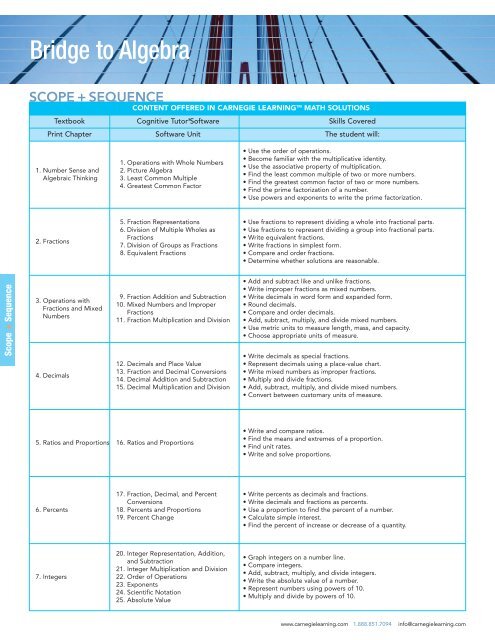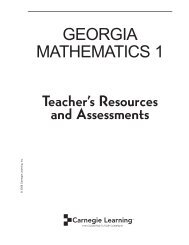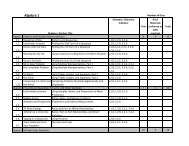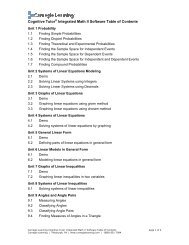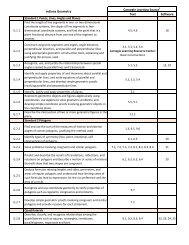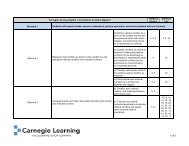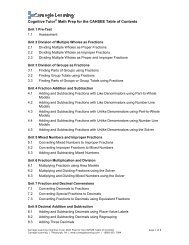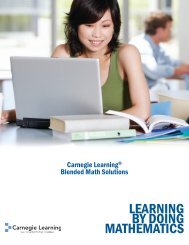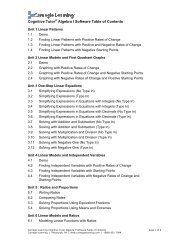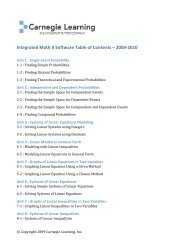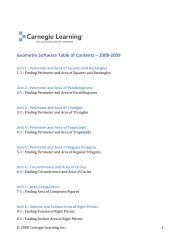Bridge to Algebra - Carnegie Learning
Bridge to Algebra - Carnegie Learning
Bridge to Algebra - Carnegie Learning
Create successful ePaper yourself
Turn your PDF publications into a flip-book with our unique Google optimized e-Paper software.
<strong>Bridge</strong> <strong>to</strong> <strong>Algebra</strong><br />
SCOPE + SEQUENCE<br />
CONTENT OFFERED IN CARNEGIE LEARNING TM MATH SOLUTIONS<br />
Textbook Cognitive Tu<strong>to</strong>r ® Software Skills Covered<br />
Print Chapter Software Unit The student will:<br />
1. Number Sense and<br />
<strong>Algebra</strong>ic Thinking<br />
1. Operations with Whole Numbers<br />
2. Picture <strong>Algebra</strong><br />
3. Least Common Multiple<br />
4. Greatest Common Fac<strong>to</strong>r<br />
• Use the order of operations.<br />
• Become familiar with the multiplicative identity.<br />
• Use the associative property of multiplication.<br />
• Find the least common multiple of two or more numbers.<br />
• Find the greatest common fac<strong>to</strong>r of two or more numbers.<br />
• Find the prime fac<strong>to</strong>rization of a number.<br />
• Use powers and exponents <strong>to</strong> write the prime fac<strong>to</strong>rization.<br />
2. Fractions<br />
5. Fraction Representations<br />
6. Division of Multiple Wholes as<br />
Fractions<br />
7. Division of Groups as Fractions<br />
8. Equivalent Fractions<br />
• Use fractions <strong>to</strong> represent dividing a whole in<strong>to</strong> fractional parts.<br />
• Use fractions <strong>to</strong> represent dividing a group in<strong>to</strong> fractional parts.<br />
• Write equivalent fractions.<br />
• Write fractions in simplest form.<br />
• Compare and order fractions.<br />
• Determine whether solutions are reasonable.<br />
Scope + Sequence<br />
3. Operations with<br />
Fractions and Mixed<br />
Numbers<br />
4. Decimals<br />
9. Fraction Addition and Subtraction<br />
10. Mixed Numbers and Improper<br />
Fractions<br />
11. Fraction Multiplication and Division<br />
12. Decimals and Place Value<br />
13. Fraction and Decimal Conversions<br />
14. Decimal Addition and Subtraction<br />
15. Decimal Multiplication and Division<br />
• Add and subtract like and unlike fractions.<br />
• Write improper fractions as mixed numbers.<br />
• Write decimals in word form and expanded form.<br />
• Round decimals.<br />
• Compare and order decimals.<br />
• Add, subtract, multiply, and divide mixed numbers.<br />
• Use metric units <strong>to</strong> measure length, mass, and capacity.<br />
• Choose appropriate units of measure.<br />
• Write decimals as special fractions.<br />
• Represent decimals using a place-value chart.<br />
• Write mixed numbers as improper fractions.<br />
• Multiply and divide fractions.<br />
• Add, subtract, multiply, and divide mixed numbers.<br />
• Convert between cus<strong>to</strong>mary units of measure.<br />
5. Ratios and Proportions 16. Ratios and Proportions<br />
• Write and compare ratios.<br />
• Find the means and extremes of a proportion.<br />
• Find unit rates.<br />
• Write and solve proportions.<br />
6. Percents<br />
17. Fraction, Decimal, and Percent<br />
Conversions<br />
18. Percents and Proportions<br />
19. Percent Change<br />
• Write percents as decimals and fractions.<br />
• Write decimals and fractions as percents.<br />
• Use a proportion <strong>to</strong> find the percent of a number.<br />
• Calculate simple interest.<br />
• Find the percent of increase or decrease of a quantity.<br />
7. Integers<br />
20. Integer Representation, Addition,<br />
and Subtraction<br />
21. Integer Multiplication and Division<br />
22. Order of Operations<br />
23. Exponents<br />
24. Scientific Notation<br />
25. Absolute Value<br />
• Graph integers on a number line.<br />
• Compare integers.<br />
• Add, subtract, multiply, and divide integers.<br />
• Write the absolute value of a number.<br />
• Represent numbers using powers of 10.<br />
• Multiply and divide by powers of 10.<br />
www.carnegielearning.com 1.888.851.7094 info@carnegielearning.com
<strong>Bridge</strong> <strong>to</strong> <strong>Algebra</strong><br />
CONTENT OFFERED IN CARNEGIE LEARNING TM MATH SOLUTIONS<br />
Textbook Cognitive Tu<strong>to</strong>r ® Software Skills Covered<br />
Print Chapter Software Unit The student will:<br />
8. <strong>Algebra</strong>ic Problem<br />
Solving<br />
26. Picture <strong>Algebra</strong> and Equations<br />
27. Patterns and Expressions<br />
28. One-Step Unit Conversions<br />
29. Patterns and One-Step Equations<br />
30. One-Step Equations<br />
31. Patterns and Two-Step Equations<br />
32. Expression Evaluation<br />
33. Two-Step Equations<br />
34. Problem Solving with Two-Step Equations<br />
35. First Quadrant Graphs<br />
36. Graphs of Inequalities<br />
• Evaluate expressions.<br />
• Solve one- and two-step equations.<br />
• Identify and graph points in the coordinate plane.<br />
• Make a table of values.<br />
• Create a graph of ordered pairs.<br />
• Use equations, tables, and graphs <strong>to</strong> solve problems.<br />
9. Geometric Figures<br />
and Their Properties<br />
37. Angles and Angle Pairs<br />
38. Triangles, Quadrilaterals, and<br />
Polygons<br />
39. Introduction <strong>to</strong> Similar Triangles<br />
• Determine measures of angles and identify special angle pairs.<br />
• Classify triangles, quadrilaterals, and polygons.<br />
• Find angle measures in polygons.<br />
• Determine whether polygons are similar or congruent.<br />
• Find measurements indirectly.<br />
10. Area and the<br />
Pythagorean<br />
Theorem<br />
40. Squares and Square Roots<br />
41. Perimeter and Area<br />
42. Pythagorean Theorem<br />
43. Distance and Midpoint<br />
• Find perimeters and areas of rectangles.<br />
• Explain the effect on perimeter and area of changing dimensions.<br />
• Find circumferences and areas of circles.<br />
• Find areas of triangles, parallelograms, and trapezoids.<br />
• Find areas of composite figures.<br />
• Find and estimate square roots of numbers.<br />
• Prove and use the Pythagorean Theorem and its converse.<br />
Scope + Sequence<br />
11. Probability and<br />
Statistics<br />
44. Single Event Probability<br />
45. Independent and Dependent<br />
Probabilities<br />
46. Measures of Central Tendency<br />
• Find the probability of an event.<br />
• Understand independent and dependent events.<br />
• Find the probability of a compound event.<br />
• Find the mean, median, mode, and range of a set of data.<br />
• Create and interpret frequency tables and his<strong>to</strong>grams.<br />
• Create and interpret stem-and-leaf plots, box-and-whisker plots, and<br />
circle graphs.<br />
12. Volume and Surface<br />
Area<br />
47. Volume and Surface Area<br />
• Find volumes of prisms, cylinders, pyramids, cones, and spheres.<br />
• Find surface areas of prisms, cylinders, and spheres.<br />
• Design nets for three-dimensional objects.<br />
• Construct side, front, and <strong>to</strong>p views of three-dimensional objects.<br />
13. Linear Functions<br />
48. Linear Functions<br />
• use tables, graphs, and function notation <strong>to</strong> represent functions<br />
• graph lines using slopes and intercepts<br />
• create scatter plots of data<br />
• find a line of best fit for a set of data<br />
14. Number Systems<br />
49. Rational and Irrational Numbers<br />
50. Operations with Rational Numbers<br />
• Use a number line <strong>to</strong> compare and order rational numbers.<br />
• Perform operations with rational numbers.<br />
• Identify decimals as terminating or repeating.<br />
• Write repeating decimals as fractions.<br />
• Identify irrational numbers.<br />
• Classify numbers in the real number system.<br />
15. Transformations 51. Geometric Transformations<br />
• Understand the four quadrants of a coordinate plane.<br />
• Identify and plot points in a coordinate plane.<br />
• Make and use scale drawings and scale models.<br />
• Graph translations, rotations, reflections, and dilations.<br />
• Graph multiple transformations in a coordinate plane.<br />
www.carnegielearning.com 1.888.851.7094 info@carnegielearning.com


